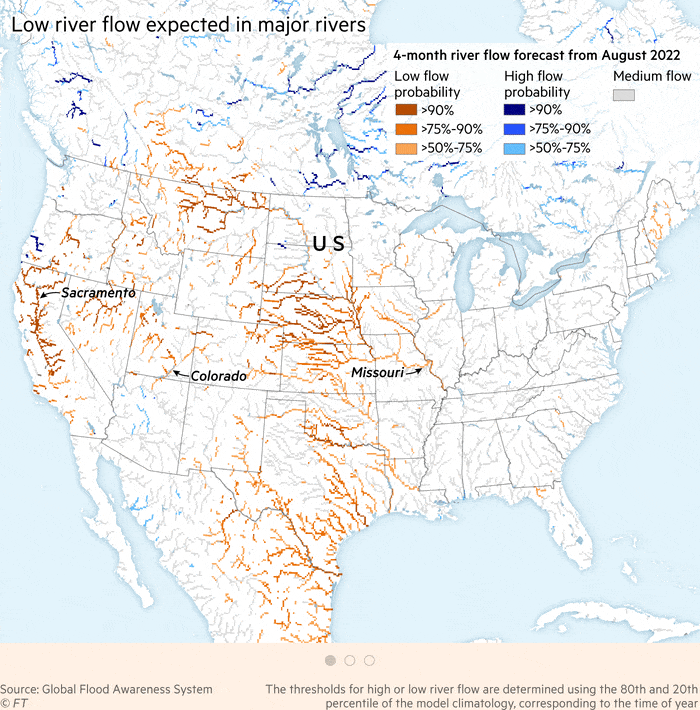Record lows for rivers across China, US and Europe sap economies

Factories grinding to a halt, crops devastated, cargo ships forced to carry smaller loads and millions facing a risk of blackouts — these are just some of the drastic consequences of record low river levels during droughts that are gripping the US, Europe and now China.
In the US, the historic lows in water levels in the critical Colorado Basin as a result of the southwestern ‘megadrought’ prompted a federal demand for the states of Arizona and Nevada to cut their water allocations by 21 and 8 per cent respectively in the year ahead, in an order from the Bureau of Reclamation last week.
In China, companies including Toyota and Foxconn halted factory operations for at least a week as hydropower shortages worsened. The province of Sichuan relies heavily on hydropower, and the vital Yangtze, the longest river in Asia, reached its lowest level on record for August. Shipping along the nation’s most important waterway was also affected.
Europe continued to suffer as unusually hot and dry weather pushed down the level of the critical Rhine, a major artery that is relied on by industry throughout Germany, Switzerland and the Netherlands. Cargo ships have had to reduce their loads, which has led to higher transport costs and supply chain delays. Limited respite was forecast on the weekend, with rainfall expected in some parts.
“Flowing from the Swiss Alps to the North Sea, the Rhine River is an important shipping route for many products from grains to chemicals to coal,” said the European Space Agency. “When water levels drop, cargo vessels need to sail with reduced load, so they don’t run aground.”
A severe drought in Italy has hit the agricultural sector, as the economically-important Po has reached unusually low levels.
There are many different types of drought, such as agricultural or hydrological, which are complex events that cannot always be definitively linked to climate change. But their impacts are increasingly stark, with extended periods of unusually hot and dry weather, and associated low water levels, recorded in many places around the world this year.
In Alpine regions, as glaciers melt the warming effect is magnified as the darker arid rock that is exposed absorbs the sun’s heat, rather than reflecting it.
“Droughts are not very easy to define and not every drought is the same,” said Liz Bentley, chief executive of the UK’s Royal Meteorological Society. “A changing climate is likely to bring greater variability in rainfall and higher temperatures, meaning that water management may become more of a challenge.”
In the US, the decades-long drought has seen states such as California struggling to restrict water usage for several years. This year, the water levels in the Colorado Basin, a crucial resource for states including Nevada, Arizona and California, have prompted authorities to warn about hydroelectricity shortages causing blackouts.
“The prolonged drought afflicting the west is one of the most significant challenges facing our communities and our country,” said Tommy Beaudreau, deputy secretary of the US Department of the Interior, in a briefing last week.
“The growing drought crisis is driven by the effects of climate change, including extreme heat and extreme precipitation,” he said, adding that around 93 per cent of the western US was experiencing drought or abnormally dry conditions.
Camille Calimlim Touton, the Bureau of Reclamation commissioner, said the system was “approaching a tipping point,” which required states reliant on the Basin to significantly reduce the amount of water they used.
The first six months of 2022 marked the sixth-hottest January-June period on record, according to the US National Oceanic and Atmospheric Administration. The seven years to 2021 were the hottest on record, according to Copernicus, the EU’s Earth monitoring programme.
The world has already warmed by about 1.1C compared to pre-industrial times, and will continue to warm for some time even if every country achieved net zero greenhouse gas emissions tomorrow, according a report from the UN body of scientists.
Global infrastructure and national economies are expected to continue to struggle to cope with the costly consequences of extreme weather that scientists predict as a result.
Shifts observed in the jet stream have contributed to heatwaves, wildfires and drought in the northern hemisphere, while the unusual phenomenon of back-to-back La Niña weather patterns has resulted in flooding and unseasonably cold weather in the south, with floods in Australia and South Africa. In New Zealand last week an estimated 1200 people were displaced by torrential rain.
Global estimated insured losses from natural catastrophes in first half of 2022 stood at $35bn, 22 per cent above the average of past ten years, reinsurance group Swiss Re reported earlier this month. The group said the effects of climate change were evident in increasingly extreme weather events.
“The severe weather events of the past six months once again highlight that natural catastrophes . . . are increasing in frequency and severity in all regions,” Martin Bertogg, head of catastrophe perils at Swiss Re concluded.
Climate Capital

Where climate change meets business, markets and politics. Explore the FT’s coverage here.
Are you curious about the FT’s environmental sustainability commitments? Find out more about our science-based targets here